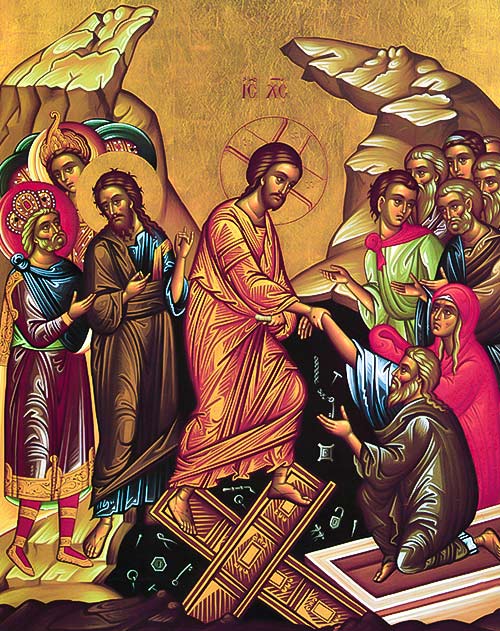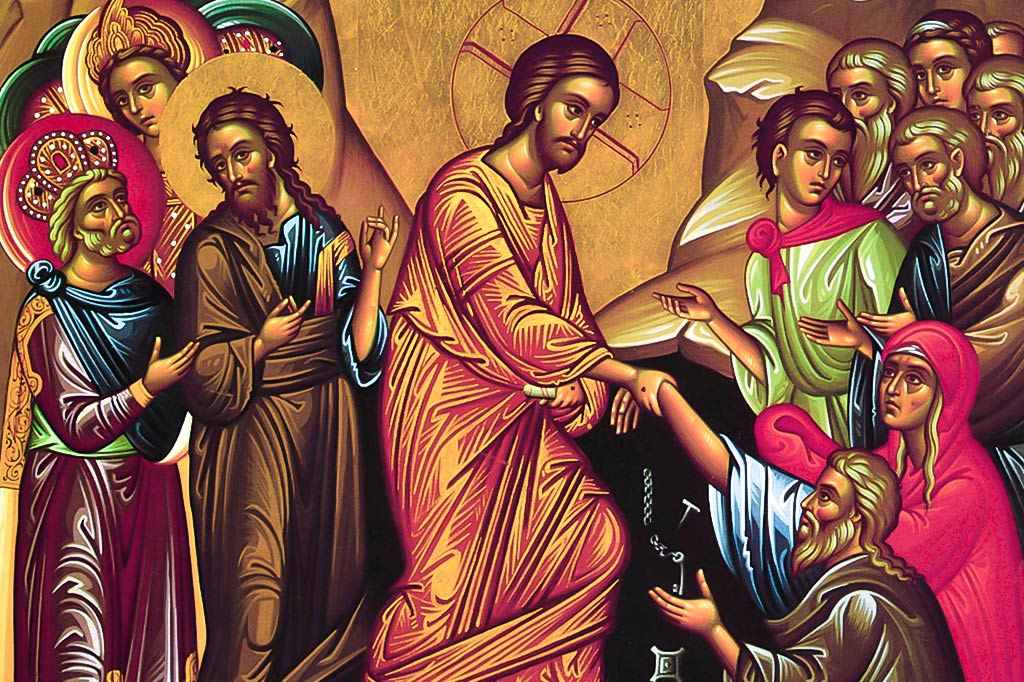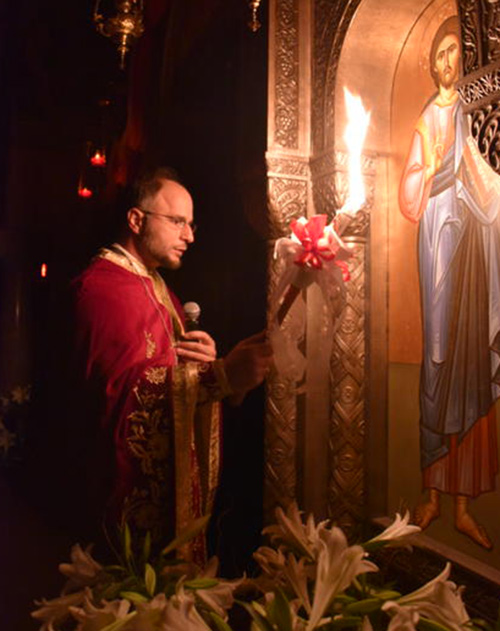How Long After Pascha Do Orthodox Christians Wait to Read the Psalms Again
Introduction
On the Neat and Holy Banquet of Pascha, Orthodox Christians celebrate the life-giving Resurrection of our Lord and Savior Jesus Christ. This banquet of feasts is the most meaning 24-hour interval in the life of the Church. It is a celebration of the defeat of death, every bit neither death itself nor the power of the grave could agree our Savior captive. In this victory that came through the Cross, Christ broke the chains of sin, and through organized religion offers united states of america restoration, transformation, and eternal life.
Commemoration of The Neat and Holy Feast of Pascha
 Holy Calendar week comes to an end at dusk of Great and Holy Sat, as the Church prepares to gloat her most ancient and preeminent festival, Pascha, the feast of feasts. The fourth dimension of training will give way to a time of fulfillment. The glorious and resplendent light emanating from the empty Tomb will dispel the darkness. Christ, risen from the dead, cracks the fortress of death and takes "captivity captive" (Psalm 67:19). All the limitations of our createdness are torn asunder. Death is swallowed upward in victory and life is liberated. "For equally by a human came death, past a human being came besides the resurrection of the dead. For equally in Adam all die, so besides in Christ shall all exist made alive" (I Corinthians xv:21-22). Pascha is the dawn of the new and unending day. The Resurrection constitutes the most radical and decisive deliverance of humankind.
Holy Calendar week comes to an end at dusk of Great and Holy Sat, as the Church prepares to gloat her most ancient and preeminent festival, Pascha, the feast of feasts. The fourth dimension of training will give way to a time of fulfillment. The glorious and resplendent light emanating from the empty Tomb will dispel the darkness. Christ, risen from the dead, cracks the fortress of death and takes "captivity captive" (Psalm 67:19). All the limitations of our createdness are torn asunder. Death is swallowed upward in victory and life is liberated. "For equally by a human came death, past a human being came besides the resurrection of the dead. For equally in Adam all die, so besides in Christ shall all exist made alive" (I Corinthians xv:21-22). Pascha is the dawn of the new and unending day. The Resurrection constitutes the most radical and decisive deliverance of humankind.
The Resurrection of Jesus Christ is the key truth and absolute fact of the Christian faith. It is the primal feel and essential kerygma of the Church building. It confirms the actuality of Christ's remarkable earthly life and vindicates the truth of His teaching. It seals all His redemptive work: His life, the model of a holy life; His compelling and unique teaching; His boggling works; and His awesome, life-creating expiry. Christ'south Resurrection is the guarantee of our salvation. Together with His Ascension it brings to perfection God's union with usa for all eternity.
The Resurrection made possible the miracle of the Church building, which in every age and generation proclaims and affirms "God'south plan for the universe, the ultimate divinization of human and the created order." The profound experience of and the unshakable belief in the risen Lord enabled the Apostles to evangelize the globe and empowered the Church to overcome paganism. The Resurrection discloses the indestructible power and inscrutable wisdom of God. It disposes of the illusory myths and conventionalities systems by which people, bereft of divine knowledge, strain to affirm the meaning and purpose of their existence. Christ, risen and glorified, releases humanity from the delusions of idolatry. In Him grave-jump humanity discovers and is filled with unequalled hope. The Resurrection bestows illumination, energizes souls, brings forgiveness, transfigures lifes, creates saints, and gives joy.
The Resurrection has not yet abolished the reality of expiry. But it has revealed its powerlessness (Hebrews 2:14-xv). We continue to dice as a result of the Fall. Our bodies decay and fall away. "God allows expiry to exist but turns information technology confronting abuse and its cause, sin, and sets a purlieus both to corruption and sin." Thus, physical death does not destroy our life of communion with God. Rather, we move from expiry to life - from this fallen world to God's reign.
Icon of the Commemoration of Smashing and Holy Pascha

One of the almost symbolic of the Festal Icons of the Orthodox Church is that of the Holy Resurrection. In the centre of this radiant outcome is Christ pulling Adam and Eve upward from their tombs. The gates of the Realm of Decease are cleaved and thrown down. Death, personified in man form is defeated, and bound paw and foot at the bottom of the scene. We recall the joyous words of St. Paul: "O death, where is thy sting? O grave, where is thy victory?" (1 Corinthians 15:55)
In the background stands the host of the departed, and then numerous they tin not be depicted. Among them in the front of the multitude are some of the righteous dead, though at present invigorated by the Resurrection. King David and his son Solomon are seen on the left wearing crowns. Well-nigh the center is Saint John the Baptist. On the other side is Abel, the son of Adam and the first man to e'er die. He wears a shepherds robe and has a cane. Many Icons of this subject depict large crowds with a few other recognizable prophets.
Orthodox Commemoration of Pascha
 Before midnight on Saturday evening, the Odes of Lamentation of the previous day are repeated. The Orthros of the Resurrection begins in complete darkness. The priest takes light from the vigil low-cal and gives information technology to the faithful, who are property candles. The priest sings: "Come ye and receive light from the unwaning light, and. glorify Christ, who arose from the dead", and all the people bring together him in singing this hymn once more and once again. From this moment, every Christian holds the Easter candle as a symbol of his vivid, deep religion in the Resurrection of Jesus Christ as Savior. In many churches the priest leads the people outside the church, where he reads the Gospel which refers to the Angels statement: "He is Risen; He is not here," (Mark 16:1-8).
Before midnight on Saturday evening, the Odes of Lamentation of the previous day are repeated. The Orthros of the Resurrection begins in complete darkness. The priest takes light from the vigil low-cal and gives information technology to the faithful, who are property candles. The priest sings: "Come ye and receive light from the unwaning light, and. glorify Christ, who arose from the dead", and all the people bring together him in singing this hymn once more and once again. From this moment, every Christian holds the Easter candle as a symbol of his vivid, deep religion in the Resurrection of Jesus Christ as Savior. In many churches the priest leads the people outside the church, where he reads the Gospel which refers to the Angels statement: "He is Risen; He is not here," (Mark 16:1-8).
Then comes the incoherent moment as the people await for the priest to get-go the hymn of Resurrection, which they bring together him in singing, repeatedly: "Christ has Risen from the dead, by expiry trampling upon Death, and has bestowed life upon those in the tombs". From this moment the unabridged service takes on a joyous Easter temper. The hymns of the Odes and Praises of Resurrection which follow are of superb meaning and expression. The people confess, "Information technology is the Solar day of Resurrection, let us be glorious, let us embrace one another and speak to those that hate usa; let us forgive all things and then let us weep, Christ has arisen from the dead". By this hymn they admit that love of one'due south fellowman is the solid foundation of the faith in the Resurrection of Christ.
The Divine Liturgy of Saint John Chrysostom is then officiated. At the finish of the Liturgy, a part of the marvelous festival sermon of Saint Chrysostom is read, which calls upon the people to "Take part in this fair and radiant festival. Let no one be fearful of death, for the death of the Savior has set united states of america costless . . . O Decease, where is thy sting? O Hades, where is Thy victory? Christ is Risen and Thou fine art overthrown. To Him be glory and power from all ages to all ages."
The Scripture readings for the Divine Liturgy are: Acts i:1-eight and John 1:one-17.
On Easter Sunday afternoon the faithful gather once more for prayer with lighted candles. All sing the hymn, "Christ is Risen from the Dead". The people greet i another joyously, saying: "Christ is Risen", the Easter salutation which is answered, "Truly He is Risen". They sing, "the dark shadows of the Law has passed abroad by the coming of grace", and standing in exaltation they exclaim, "Who is and then not bad a God as our God?"
The Gospel according to John (twenty:nineteen-25) is read in diverse languages, proclaiming the Good News of Resurrection all over the universe without discrimination. The fruit of organized religion in the Resurrection of the Lord is love in His Name; therefore, this mean solar day is called "Sunday of Agape" (love feast), a day dedicated to Christian principles, especially to forgiveness and clemency. At this time, Christians seek to end misunderstanding and arguments among those whom they may be at odds. Campaigner Paul firmly interprets the Resurrection of Christ, saying: "If Christ has not been raised, then our preaching is in vain and your faith is in vain" (1 Corinthians 15:14). The Church also states in its Creed, "The Third 24-hour interval He rose again."
Hymns of Pascha
Apolytikion (Plagal of the First Tone)
Christ is risen from the dead, by decease trampling down upon expiry, and to those in the tombs He has granted life.
Commencement Ode of the Canon of Pascha (Beginning Tone)
Information technology is the day of Resurrection, permit us be radiant, O ye peoples: Pascha, the Lord'south Pascha; for Christ God hath brought us from death to life, and from globe unto Sky as we sing the triumphal hymn.
Doxastikon of the Praises (Plagal of the First Tone)
It is the day of Resurrection; allow us be radiant for the festival, and permit us encompass one another. Let us say, O brethren, even to those that hate united states: Let united states of america forgive all things on the Resurrection; and thus allow us cry: Christ is risen from the dead, past death He has trampled down death, and on those in the tombs He has bestowed life.
References
Pentecostarion. Translated from the Greek by Holy Transfiguration Monastery (Boston: Holy Transfiguration Monastery, 1990), 27-42.
Calivas, Alkiviadis C. Great Week and Pascha in the Greek Orthodox Church (Brookline: Holy Cross Press, 1992), pp. 89-121.
Farley, Donna. Seasons of Grace: Reflections on the Orthodox Church building Year (Ben Lomond, CA: Conciliar Printing, 2002), pp. 147-152.
Wybrew, Hugh. Orthodox Lent, Holy Calendar week and Easter: Liturgical Texts with Commentary (Crestwood, NY: St. Vladimir'south Seminary Printing, 1997), pp. 113-118.
Lead photo from the Orthros Service of the Resurrection provided past Saint John the Baptist Greek Orthodox Church in Tampa, FL and used with permission.
Icon of the Anastasis provided by Theologic and used with permission
Photo of the Priest Holding the Paschal Candle provided by the Greek Orthodox Church building of Our Savior in Rye, NY and used with permission.
whitesidepilthand.blogspot.com
Source: https://www.goarch.org/pascha
0 Response to "How Long After Pascha Do Orthodox Christians Wait to Read the Psalms Again"
Post a Comment